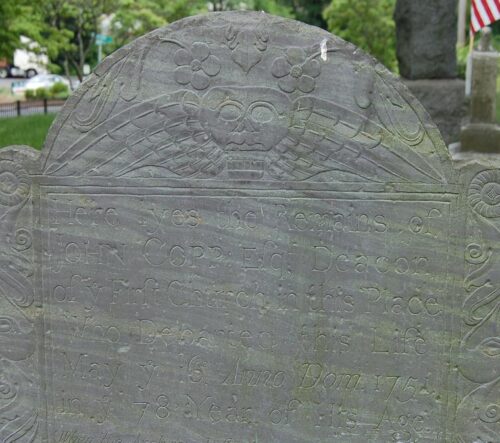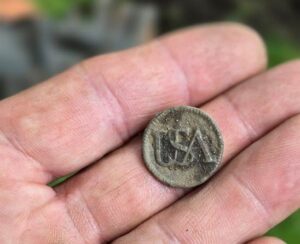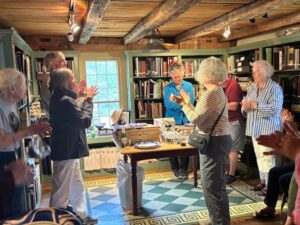Written by Susan Kweskin, Ridgefield Historical Society Volunteer
The date? August 1721
The place? A farm in Ridgefield, Connecticut
The scene:
A local farmer has been toiling all this long hot summer day, moving rocks and stones and positioning each one just so in a wall he’s been building. It’s laborious slow-going work.
The farmer had some help with the work a couple of weeks back. A young man, on his way from Boston to New York, stopped at the farm offering a few days labor in exchange for a place to sleep for a few nights. His assistance was welcomed: the farmer’s sons are far too young for this kind of work.
Tonight, after a back-breaking day alone in the field, our farmer decides to retire well before sundown — which comes late this season.
He awakens later that night, muscles aching. He’s nauseated, suddenly burning with fever. His head and lower back feel like they are on fire.
His thrashing wakes the family. His wife and older children hover anxiously around, watching over him as the sun comes up.
The farmer’s wife offers him a tincture made of cinnamon soaked in 100+ proof alcohol to stop the pain. She makes him tea with comfrey to stop the nausea. She puts a cool cloth on his forehead. Nothing she does helps. The farmer is rapidly getting worse – face and lips are swelling and his eyes are becoming so puffy he can barely see.
Summon a doctor? The family debates, for this is no small decision. Doctors aren’t generally held in high esteem. In fact, they are often feared because “their ‘cures’ kill [ed] more people than the diseases.
Dr. John Copp, the town’s first physician, lives in nearby Georgetown. Could he make it to the farm in time? He’s a busy, important man….a surveyor, school teacher, and Ridgefield’s town clerk. And what of the expense?
What remedies might Dr. Copp ply if he does manage to come in time? Whatever he brings in his doctor bag is almost certainly powerless to cure whatever it is that’s ailing the farmer. The best the good doctor can do is attempt to bring some comfort while the medical condition follows its own natural course. The worst he can do is kill his patient.
He might try to bleed his patient. After all, venesection has been practiced since antiquity to treat a variety of ailments. The surgery involves puncturing a blood vessel in the patient’s elbow or knee (or even the jugular) to remove “stagnant” (non-circulating) blood, rebalance bodily humors, and purge impure fluids. The cutting might be done with a knife, lancet, or fleam (image). Dr. Copp might also use a scarificator — a spring-loaded box with a cargo of a dozen or so knives to deliver parallel cuts. Cupping the skin would follow the cutting. A bell-shaped glass placed over the abraded skin creates suction to draw out the toxin.
Bloodletting is likened to a spontaneous bloody nose and to menstruation in which “bad blood” is naturally purged from women each month.
If Dr. Copp attempts bloodletting, he will drain the farmer’s blood into a tin or pewter container until his patient faints.
In a pinch, applications of leeches might do the trick. The bite of these creatures acts as a local anticoagulant: a single application of several leeches to the patient’s skin can drain several ounces of blood.
Bloodletting may be the therapy of choice in 1721 in colonial Connecticut, but it’s not without peril. Chief among the risks: low blood pressure, risk of infection and sepsis, difficulty breathing, and death from exsanguination.
The fleam pictured here held multiple, variably sized blades that folded into a case like a pocketknife. (Courtesy Wikipedia)
Nevertheless, the virtues of bloodletting are later endorsed by the famous physician and signer-of-the Declaration of Independence, Benjamin Rush, for whom Rush College was named. An enthusiastic bloodletter himself, Rush described the salubrious effect of the procedure this way:
“It frequently strangles a fever… imparts strength to the body… renders the pulse more frequent when it is preternaturally slow… renders the bowels, when costive, more easily moved by purging physic… removes or lessens pain in every part of the body, and more especially the head… removes or lessens the burning heat of the skin, and the burning heat of the stomach…”
If the bloodletting fails to restore humoral harmony and health, purging might. Vomiting can be induced via various homeopathic remedies including tea made from walnut tree bark “peeled upwardly.” Physicians plied more aggressive means:
“Calomel remained in favor, usually combined with medicinal wine, laxative salts, opium, and castor oil. Used to cleanse the system of foul, bilious liquids, this poison caused patients to salivate uncontrollably, bleed from the gums, and evacuate the bowels without restraint. Patients suffered horribly, losing teeth, developing sores on tongue and cheeks, dreading the doctor’s call. A popular verse went: ‘Doctor comes with free good will, but ne’er forgets his calomel.'”
Or there’s blistering. Perhaps the good doctor will place hot plasters on his patient’s skin to raise blisters and draw out poison.
Perhaps Dr. Copp, who has been summoned by the farmer’s desperate family, will attempt other remedies.
When at last he arrives, the doctor takes one look at the blisters that have populated the farmer’s entire face and chest. He immediately recognizes smallpox. He understands that there’s nothing in his bag that will help this man or his family, now all in mortal danger.
Our farmer and his family are, of course, fictitious. But Dr. Copp is not. Neither was smallpox.
Born in 1673 in Boston, John Copp moved to Connecticut as a young man. He met and married Mary Jagger Phelps in Stamford in 1698. Three years later, he married again. Around this time, he became a schoolteacher in Norwalk. (His salary of 15 pounds came from tuition paid by the “schoolers.”) He was also a surveyor — a skill he had learned from his father. In 1708, he surveyed land that was to become home to Ridgefield’s first 26 families; later that same year and he and two others who represented the town’s first 26 settlers paid local Indians 100 pounds sterling for the land. Copp also served as Ridgefield’s town clerk – a position he held until 1713 – when his successor, Thomas Hauley took the role.
Dr. Copp was one of the first physicians in the colonies. He was licensed to practice medicine in 1710, but it’s not clear where and to whom was apprenticed. “Sources for the acquisition of medical knowledge in the colonies were few and scanty.” (Medical schools wouldn’t exist for several more decades.)
John Copp, dead on May 16, 1751 at age 78, lies in the East Norwalk Historical Cemetery. The now barely discernible inscription on his tombstone carved nearly 275 years ago notes that he was “Deacon of ye first church in this place.”
Two years before his death on May 16, 1751, he freed his two slaves and made provisions for their support. Dr. Copp left no children behind.
Copp’s Mountain, east of North Street, is an 18th Century place name in Ridgefield; the use of Copps Hill Road is much later, and later still, a developer chose the name Copps Hill Plaza for his shopping center bordered by Copps Hill Road.
Dr Copp is remembered as a man who shaped Ridgefield as few others have.
As for smallpox – the so-called speckled monster –- the scourge was all too real. Epidemics of this highly contagious infection regularly swept New England…. 1721, 1752, 1764, and 1775 all saw virulent outbreaks. The infected suffered mightily:
“….the miserable being has the appearance of a putrid mass, and scarcely the semblance of a human form remains.”
Smallpox wasn’t the only feared disease, but it was particularly dreaded. Influenza, measles, and other contagions regularly cut a path of devastation across colonial New England. These and other infections absolutely devastated the indigenous people. Visitors from endemic areas were unwitting vectors. A person infected with smallpox could remain asymptomatic for a couple of weeks while the virus incubated. If the young itinerant from Boston who had helped our farmer had been harboring a fever, he would have been contagious, but likely unaware that he was a walking time bomb.
We know that Dr. Copp did not succumb to smallpox – at least not in the 1721 epidemic. It’s entirely possible that he saw patients who had the illness and had developed immunity. It’s also conceivable that he’d been vaccinated against smallpox. Variolation, a primitive form of vaccination, was introduced in Boston in 1721 – but not without controversy, anger and even outrage. The practice involved taking infectious fluid from an infected person and applying it to a cut in a healthy person’s skin to elicit a mild case of the disease. This method did work, conferring life-long immunity, though it was imprecise and could kill. Moreover, the clergy strongly opposed any interference with God’s plan to punish the sick for their sins.
As for those who were not immune? The graveyards of New England bear solemn testimony to the ravages of smallpox. For the infected, little could be done save pain relief, perhaps with opium or laudanum. These unfortunates were treated like lepers – a strict quarantine imposed on the family to keep neighbors and friends far away. Families with an infected member were instructed to “hang out on a pole at least six feet in length, a red cloth not under one yard long, and a half yard wide, from the most public part of the infected house.”
Coda: The World Health Organization described smallpox as “one of the most devastating diseases known to humanity.” In 1980, it declared that the virus had successfully been eradicated from the planet. The last known natural case occurred in Somalia in 1977.
Bloodletting continued to be widely practiced until the 20th century when it eventually fell out of favor.





